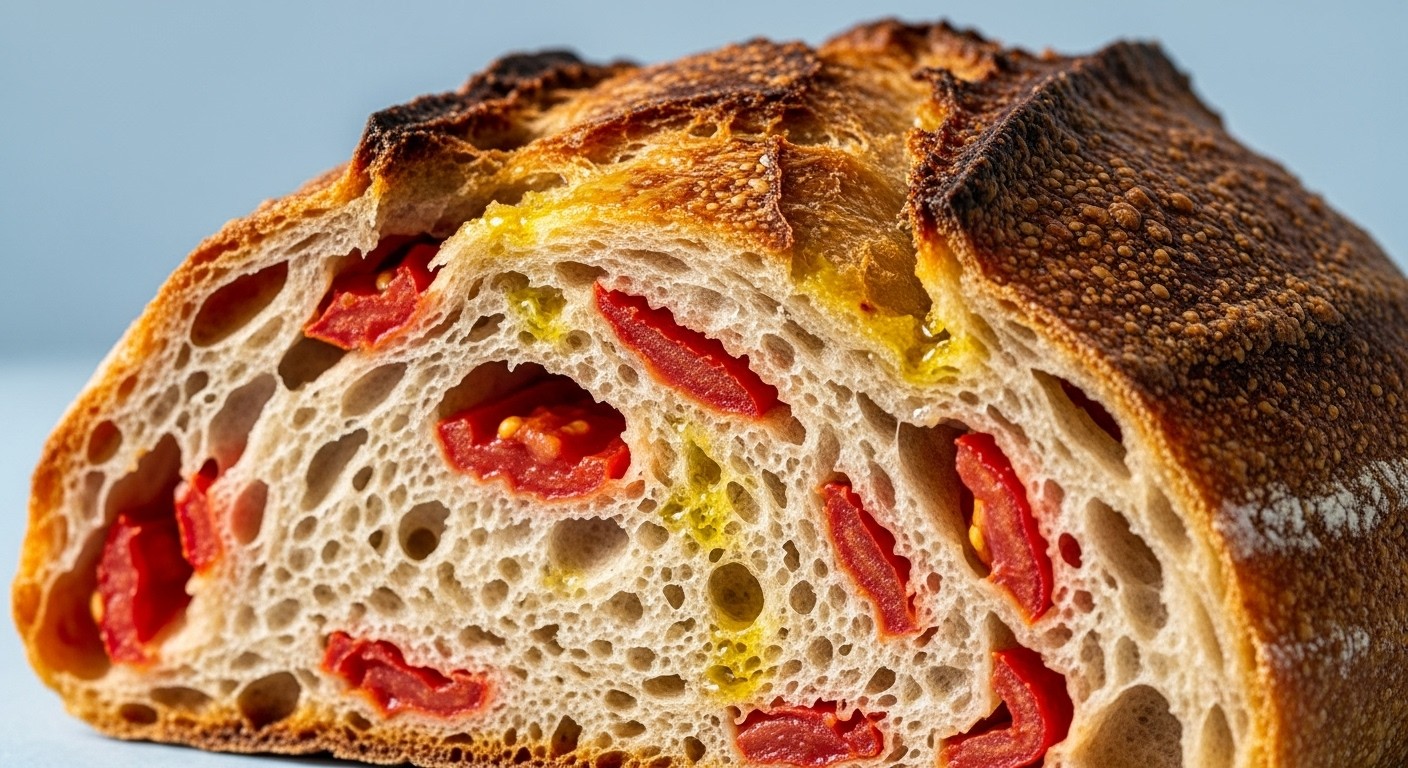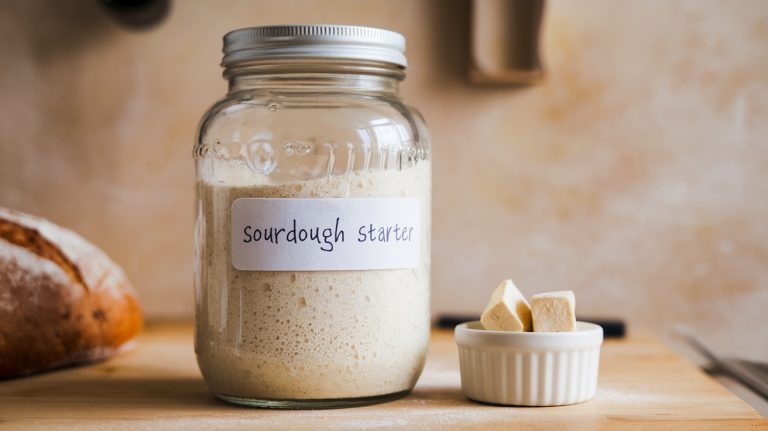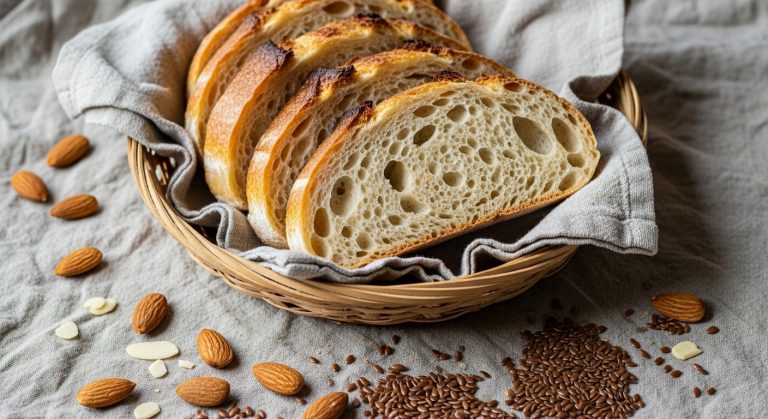Tomato Sourdough Bread: Bold & Tangy Masterpiece
Immerse yourself in crafting tomato sourdough bread with vibrant, tangy flavors. You’ll blend roasted Roma tomato puree with an active sourdough starter, bread flour, and a touch of whole wheat for depth.
Mix with wet hands to form a tacky dough, then enhance it with basil and sun-dried tomatoes. Roast tomatoes with olive oil and garlic for rich savoriness. Proof at 78-80°F for a perfect rise. Stick around to uncover more baking secrets.
Key Takeaways
- Use bread flour and whole wheat flour with active sourdough starter for structure and flavor in tomato sourdough bread.
- Incorporate roasted tomato puree and olive oil for authentic taste, adjusting hydration for a tacky dough consistency.
- Enhance flavor with herbs like basil and oregano, adding during stretch and folds for even distribution.
- Maintain dough temperature at 78-80°F and proof until doubled, using cold fermentation for deeper flavor.
- Bake in a Dutch oven at 500°F, reducing to 450°F, for a crisp crust and rich texture.
Essential Ingredients for Tomato Sourdough

As you begin on crafting a loaf of tomato sourdough, selecting the right ingredients is the foundation of achieving that perfect balance of texture and flavor. Delve into choosing bread flour for structure and chewiness, and blend in whole wheat flour for a nutty depth that fuels fermentation.
Embark on your tomato sourdough journey by picking the finest bread flour for structure and whole wheat for a nutty, fermentation-boosting depth.
Your sourdough starter’s gotta be active—bubbly and doubled in size—to guarantee a robust rise and tangy complexity; measure it by weight for precision. For added convenience, consider using a pre-made mix like Krusteaz Sourdough Bread Mix, which offers high-quality sourdough culture and simplifies the baking process.
Don’t skimp on salt; it sharpens flavor and controls yeast, while extra virgin olive oil enriches the crumb and boosts crust color. Add water to fine-tune hydration, and consider a pinch of chili flakes or Parmesan for an umami kick. For an authentic savory profile, incorporate tomato puree made from roasted fresh tomatoes or sun-dried tomatoes to infuse a unique tomato flavor.
Preparing the Tomato Mixture
Before you immerse yourself in mixing your tomato sourdough, let’s craft a vibrant tomato mixture that’ll infuse your loaf with bold, tangy flavor.
Start by selecting sweet Roma or vine-ripened tomatoes, blending them with a touch of tomato paste or sun-dried tomatoes for depth.
Roast them first with olive oil, garlic, salt, and pepper to amplify their richness, then purée until smooth.
Cool the mixture completely to protect your yeast. For best results, use a digital scale to measure your ingredients accurately before combining them with the tomato mixture.
Add a splash of tomato juice for intensified taste and a reddish-pink hue, adjusting hydration as needed.
Enhance with fresh basil or rosemary, and a hint of roasted garlic for savory notes. Drawing from traditional sourdough methods, this tomato mixture complements the natural fermentation process used in the bread.
Aim for a pourable consistency, using 1 to 1.5 cups, and store any extra in the fridge.
Mixing and Kneading the Dough
Now that your vibrant tomato mixture is ready, let’s get to the heart of crafting your tomato sourdough by mixing and kneading the dough.
Start by combining the tomato purée, levain, and water in a large bowl, mixing until fully blended.
Begin your tomato sourdough journey by blending tomato purée, levain, and water in a large bowl until perfectly combined.
Add salt, whole wheat flour, and bread flour, stirring with wet hands to form a sticky, shaggy mass.
Hold back some water, adding it gradually to perfect the hydration—aim for sticky but manageable. Remember that proper hydration is crucial for achieving the desired dough consistency.
Use the pinch and fold method to incorporate ingredients, then switch to stretch and folds to build gluten strength.
Repeat folds every 30 minutes, resting the dough covered in between.
Watch it transform from shaggy to smooth and elastic with each passionate knead!
Additionally, consider how preserving ingredients like tomato purée in vacuum-sealed jars can extend their freshness with strong suction power for optimal storage.
Fermentation and Proofing Process
While your tomato sourdough dough rests after kneading, immerse yourself in the essential fermentation and proofing process with enthusiastic anticipation. Plunge into bulk fermentation, watching for a 50-75% volume increase over several hours, guided by visual cues, not just time.
Perform 3-4 sets of stretch and folds every 30-60 minutes, using wet hands to gently strengthen gluten and redistribute yeast. Notice how tomato purée’s acidity subtly slows yeast activity, enriching flavor—adjust timing accordingly. Keep the dough in a warm kitchen environment warm kitchen environment to maintain consistent fermentation temperatures around 72°F.
After initial fermentation, opt for a cold ferment in the fridge for 12-18 hours, or up to 72, to deepen taste and ease scheduling. Remember that fermentation temperature control plays a critical role in flavor development and rise speed during this process.
Monitor proofing with the finger poke test, ensuring perfect aeration for a vibrant crumb and stellar oven spring.
Shaping the Bread Loaf
As you shift to shaping your tomato sourdough bread, explore this essential step with fervor and focus. With lightly floured hands or a bench scraper, work on a clean, dry surface to maintain control.
Gently handle the dough to preserve its airy bubbles, building tension for a tight, smooth surface. Stretch and fold with precision, whether crafting a round boule, an elongated batard, or a neat sandwich loaf, tucking edges underneath for strength. Shaping is crucial for both the aesthetic appeal and baking quality of your bread, ensuring the final form impacts crust and crumb ratio crust and crumb ratio. Dust the banneton with rice flour to create a non-stick surface before placing the shaped dough inside.
Keep your workspace at 78-80°F with moderate humidity to prevent stickiness. Avoid direct sunlight and ensure cleanliness to protect your dough.
After shaping, cover it with a tea towel and support it in a banneton, handling it tenderly to maintain its structure.
Baking Tips and Techniques
As you set out on baking your Tomato Sourdough Bread, focus intensely on perfecting dough consistency by ensuring it’s tacky yet manageable, striking that ideal balance for a stellar rise.
Don’t rush the proofing times—monitor them meticulously, aiming for a doubled volume over 4-6 hours at room temperature to guarantee a light, airy crumb. Remember that adding tomatoes to the dough can increase its elasticity, making it easier to handle and shape for a better loaf. To achieve precise measurements for consistent results, invest in a high-quality baking scale with 1-gram precision increments for accurate ingredient portions.
And for those vibrant flavor layers, meticulously fold in sun-dried tomatoes and herbs like basil during the final stretch, ensuring every bite bursts with tangy, aromatic depth.
Perfecting Dough Consistency
When you’re diving into the art of crafting tomato sourdough bread, perfecting dough consistency becomes your ultimate mission. Tomato purée adds moisture, so adjust water sparingly to hit that ideal sticky-yet-workable texture.
Start with a tacky dough, mixing it with wet hands to blend the purée, levain, salt, and flours seamlessly. Let it rest for 20 minutes to hydrate the flour and kickstart gluten formation. Handle the dough gently to preserve bubbles and maintain its delicate structure during the process.
Keep hydration balanced—aim for dough at 78-80ºF (25-27ºC) to optimize yeast activity. Build strength with stretch and folds over a few hours, wetting hands to avoid tearing. Pull and fold meticulously, turning the bowl for even gluten alignment.
Master this, and you’ll craft a dough that’s elastic, strong, and ready for greatness.
Optimal Proofing Times
Dive right into mastering ideal proofing times for your tomato sourdough bread, and you’ll uncover the secret to a perfect rise. At 72°F (22°C), expect about 10 hours of proofing, while a fridge retardation stretches it to 10-16 hours for a slow, controlled ferment.
Warmer spots speed things up, so find a draft-free nook; cooler environments demand patience. With tomatoes adding moisture, you might need a bit longer—watch for that buoyant, aerated feel. Remember that proofing is essential for building flavor and texture in your bread, ensuring a delightful taste and structure.
Use the poke test: a slow spring-back means it’s ready. Cover your dough to lock in humidity, and monitor temperature closely for consistency. A quality proofing basket can support dough structure during this crucial stage.
Adjust based on your space and schedule—don’t let over-proofing collapse your masterpiece.
Enhancing Flavor Layers

While perfect proofing sets the stage, it’s in enhancing the flavor layers of your tomato sourdough bread where you’ll truly ignite your loaf’s potential.
Immerse yourself in bold ingredients like sun-dried tomatoes for intense richness, fresh basil for a vibrant herbaceous punch, and capers for a tangy, salty bite. Sprinkle in oregano and red pepper flakes to weave earthy warmth and fiery zest. Experiment with incorporating these add-ins during the stretch and fold phase to ensure even distribution throughout the dough.
Elevate further with techniques—bake in a Dutch oven at a scorching 500°F, dropping to 450°F, to lock in steam and craft a crust bursting with depth. Let longer fermentation with a robust starter amplify complexity. Additionally, consider cold proofing for 24-48 hours to develop complex flavor profiles and enhance the overall taste of your loaf.
Serving Suggestions and Pairings
As you explore the delightful world of tomato sourdough bread, you’ll find endless ways to elevate its tangy, robust flavor with inspired pairings. Immerse yourself in classic bruschetta by topping toasted slices with diced tomatoes, basil, and a drizzle of olive oil, or pair with creamy burrata for a luxurious bite.
Dip into warming tomato soup for comfort, or savor with hearty beef stew. For an authentic touch, try rubbing the toasted bread with cut garlic clove before adding toppings, enhancing the flavor profile with a traditional Italian flair. Don’t forget to score your loaf with precise scoring techniques to achieve a beautifully risen crust that complements these pairings.
Check out these vibrant pairings to ignite your palate:
| Pairing Style | Suggestion |
|---|---|
| Classic Bruschetta | Fresh tomatoes, basil, olive oil |
| Fresh Accompaniment | Heirloom tomatoes, dill-lemon mayo |
| Savory Protein | Tuna melt with cheddar |
| Simple Dip | Extra-virgin olive oil |
| Warming Comfort | Tomato soup |
Frequently Asked Questions
Can Tomato Sourdough Bread Be Frozen?
You’ve gotta know if you can freeze that special bread of yours! Absolutely, you can preserve its unique flavor and texture by freezing it.
Make sure you cool it completely for at least 6 hours to avoid sogginess. Wrap it tightly in foil, then seal it in an airtight bag.
Freeze whole or sliced, and you’ll enjoy that delightful taste for up to 3 months with proper care.
Is Tomato Sourdough Gluten-Free Possible?
You’ve gotta know if gluten-free sourdough is possible, right? Absolutely, it is! Jump into using gluten-free flours like buckwheat or rice, and craft a dedicated gluten-free starter with precision.
Embrace longer fermentation to ease digestion, though it won’t erase all gluten traces unless ingredients are strictly gluten-free. You’re passionate about baking, so experiment boldly, balance ratios meticulously, and create a loaf that’s safe and scrumptious for everyone.
How Long Does Tomato Sourdough Last?
You won’t believe how long your homemade sourdough can defy time itself! Passionately crafted, this tangy delight typically lasts 3 to 5 days at room temperature when stored right.
Keep it in a paper bag or wrap it in a tea towel to lock in moisture. Don’t refrigerate—it’ll dry out faster! With natural acidity as your ally, you’re ensuring every slice stays fresh and irresistibly chewy for days.
Can I Use Canned Tomatoes Instead?
You’re wondering if you can use canned tomatoes instead, and I’m thrilled to say yes! Immerse yourself in their year-round availability and consistent, robust flavor that’ll elevate your dish.
You’ll love their blendability and nutrient punch, like lycopene and fiber. Just remember, drain excess liquid to nail the texture, and tweak seasonings for that perfect balance.
What’S the Origin of Tomato Sourdough?
Picture yourself wandering through ancient markets, the air thick with the scent of fermenting grains and wild yeasts. You’re curious about the roots of unique bread flavors, aren’t you? Immerse yourself in history, and you’ll find no ancient trace of tomato-infused loaves.
Instead, imagine modern bakers passionately experimenting, blending vibrant tomatoes into sourdough for bold color and tangy moisture. That’s where this creative fusion truly begins, in today’s innovative kitchens.
Tomato Sourdough Triumph: A Loaf to Remember
You’ve just crafted a masterpiece with this tomato sourdough bread. Revel in the rich, tangy flavors you’ve created.
Did you know that sourdough’s fermentation can boost digestibility by up to 50% compared to regular bread? That’s a game-changer for your gut. Slice into that crusty loaf, savor the vibrant tomato essence, and pair it with a sharp cheese or fresh basil. Your kitchen’s now a haven of artisanal delight.







